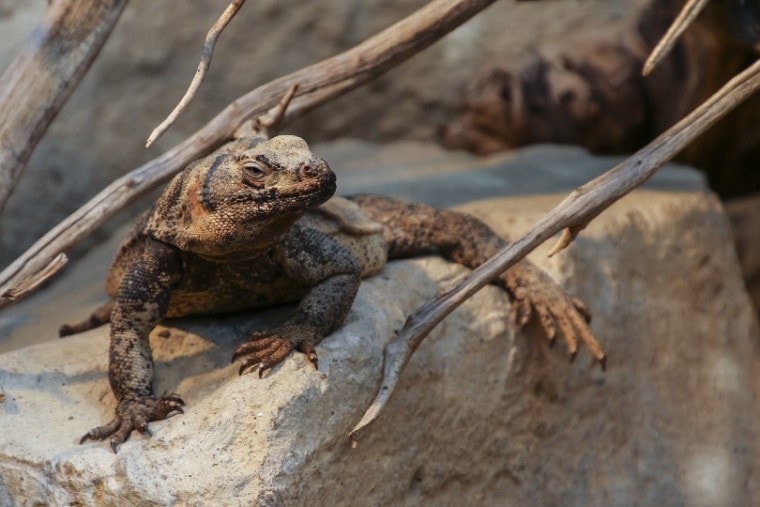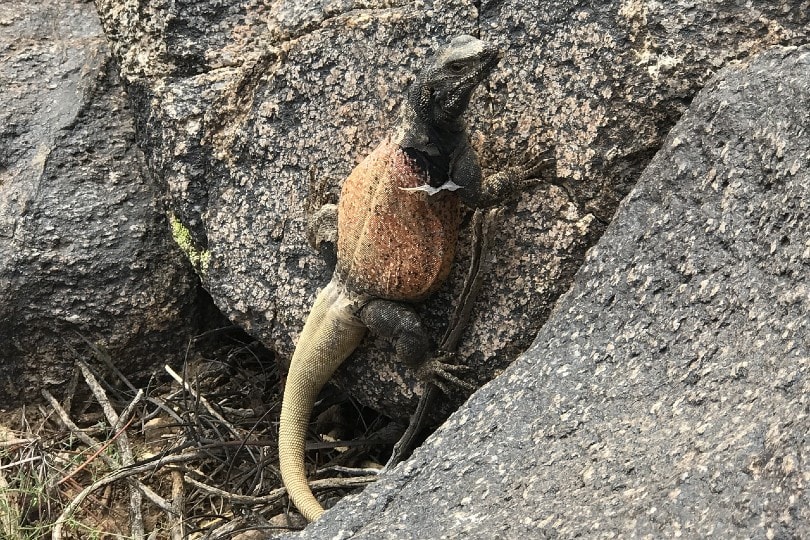
Are you an experienced lizard owner looking to add a bit of spice to your collection? If so, you may want to check out Chuckwallas. Chuckwallas are large lizards that adjust to captivity well, so long as the owner knows how to care for the tank and lizard properly.
Although Chuckwallas are a bit difficult to find and are expensive once you find them, they can make great pets. They are large, making them easy to spot, and they adjust to captivity and being handled much better than other lizards.
To find out more about Chuckwallas and what you can expect if you were to own one, keep reading. This care sheet tells you everything you need to know to properly care for a Chuckwalla in captivity.
Quick Facts About Chuckwallas
| Species Name: | Chuckwalla |
| Family: | Iguanidae |
| Care Level: | Intermediate to experienced |
| Temperature: | 70 – 120 degrees Fahrenheit with basking area |
| Temperament: | Skittish but more tolerant of handling |
| Color Form: | Dark gray with other color variations |
| Lifespan: | 20 years |
| Size: | 15 – 20 inches |
| Diet: | Vegetarian, primarily leafy greens and vegetables |
| Minimum Tank Size: | 4 x 4 x 4 feet |
| Tank Set-Up: | Non-moist substrate with hot, lit, and dry environment controllers |
| Compatibility: | Lizard owners with experience and extra money to spend |
Chuckwalla Overview
Chuckwallas are a very large breed of lizard. Many people like these unique lizards because they are fun to watch, are more tolerant of being handled, and are a unique animal to have in your home.
These animals are native to the Mojave Desert that is found between America and Mexico, but they can be found in other locations as well. Most often, Chuckwallas have dark-colored colorations and scales. The exact coloration depends on their native location. In comparison to other lizards, they have a flat but wide body.
Even though Chuckwallas are really unique and more suited for handling, they are not the most known lizard today. Because of their rarity, high price, and specific requirements, only experienced reptile owners handle these lizards at all.

How Much Do Chuckwallas Cost?
Chuckwallas are not a popular animal within the pet trade, making their prices pretty expensive. You can expect to pay between $150 and $200 for a common Chuckwalla. If you want a Sant Esteban Chuckwalla, you can expect to pay between $800 and $1,500.
Chuckwallas used to be way more common than they are now. To find a Chuckwalla today, you will likely need to look online for a breeder. We recommend selecting a breeder that works with captive bred reptiles exclusively.
Typical Behavior & Temperament
As with other lizard types, Chuckwallas can be skittish. Wild-caught Chuckwallas are especially skittish and temperamental when kept in captivity. However, these lizards adjust to captivity much better than other lizards and reptiles.
Although the Chuckwalla will never love being handled as much as a dog, these lizards tolerate being handled much quicker than other lizard types. Especially if you gently expose the Chuckwalla to your hand and eventually build up to handling, your Chuckwalla will be docile and accustomed to being held.
Appearance & Varieties
Chuckwallas are a large type of lizard. In total, there are six different species of Chuckwallas, and each species looks slightly different from one another. Nevertheless, most Chuckwallas share common physical attributes.
For example, Chuckwallas have wide, stocky bodies. Their middle sections are flat, but the bellies protrude outwards. Loose folds of skin cascade down the Chuckwalla’s body, starting from the neck area and flowing down the bulk of its midsection.
This species of lizard is sexually dimorphic. The males have black heads, shoulders, and limbs, whereas the bodies can be a number of colors, including red, pink, orange, yellow, or light gray. Once again, the native location will largely determine the Chuckwalla’s exact coloration.
Comparatively, females and juveniles have spots and contrasting bands that flow down their body. These bands typically contrast between dark colors and a shade of grey or yellow.

How to Take Care of Chuckwallas
One reason that many people do not opt for a Chuckwalla is that they have pretty extensive housing requirements. Because these lizards are so large, they need a large vivarium. Plus, they need very warm and dry environments that are monitored closely.
Habitat, Tank Conditions & Setup
Because Chuckwallas are so large, it is best to select a vivarium that is 4 x 4 x 4 feet and includes vents and glass doors. If you need additional insulation, you can look for a wooden vivarium, but you can opt for a glass model if the area you live in is not particularly cold.
Inside the vivarium, put down bedding that is comfortable and safe for the lizard. You can use a coarse beech woodchip option, or some sort of sand, soil, and clay mixture.
You need to decorate the tank to match the lizard’s natural environment too. These lizards love to bask and layout on rocks. Selecting natural rocks, wooden decorations, and artificial ornaments can be a great choice.
More important than the decoration within the tank is its heat, humidity, and light. Because Chuckwallas evolved to survive harsh desert climates, they cannot handle regular room temperature, low light, or high humidity.
Instead, Chuckwallas needs a basking area that is between 100 and 120 degrees Fahrenheit during the day hours. Shoot for the basking area to cover about 1/3 of the enclosure. The rest of the enclosure should be between 70 and 80 degrees Fahrenheit.
In order to maintain the temperature inside the enclosure, use a controlled thermostat so that it monitors the temperature throughout the day. Turn off the basking lamp during the nighttime so that the habitat mimics the sun and moon cycle.
In addition to temperature, you have to be careful about the lighting you provide. Since Chuckwallas bask at all times, they need a frequent UV light source. Opt for a 10% to 12% UV tube that covers about 2/3 of the enclosure.
Unlike amphibians and other lizards, Chuckwallas do not need high humidity since they survive in the desert. Simply keep a water bowl that is non porous inside the enclosure. Occasionally, Chuckwallas may like to be misted as a treat, but don’t mist the vivarium so much that it affects the humidity.
Do Chuckwallas Get Along with Other Pets?
You should not expose your Chuckwalla to other pets. Other animals can be harmful or stressful for the Chuckwalla. To ensure your Chuckwalla feels comfortable inside its enclosure, place it away from other pets, especially large or loud animals like dogs.
With that being said, you certainly can place more than one Chuckwalla inside the vivarium, so long as you get a tank large enough for more than one adult-size Chuckwalla. Remember: placing a male and female together will likely result in babies!

What to Feed Your Chuckwalla
Chuckwallas are vegetarians. Babies (under one-year-old) need finely chopped greens once a day. You can also supplement edible flowers into the baby Chuckwalla’s diet. As for adults, feed chopped greens, vegetables, and flowers on occasion.
There are a few vegetables that you should not feed to your Chuckwalla, including onions, iceberg lettuce, spinach, and peas. Some of these foods are toxic, whereas others can cause diarrhea from the high water content.
It’s a great idea to add supplements to your Chuckwalla’s diet as well. Calcium and multivitamin powders should be dusted on your Chuckwalla’s food a couple of times a week. These supplements will ensure that the Chuckwalla gets enough calcium and vitamin D to properly digest food and live a healthy life.
Keeping Your Chuckwalla Healthy
If you provide a Chuckwalla a correct habitat and diet, it will adjust to captivity pretty easily and live healthfully. In addition to setting up the habitat correctly, you need to routinely clean it and monitor its temperature, lighting, and humidity.
We recommend spot cleaning the vivarium once a day. This will allow you to keep the tank habitable for the lizards. At the same time, it will allow you to quickly detect if there is an issue with the lighting or heat source and fix it before your lizards get hurt.
The last tip for keeping your Chuckwalla healthy has already been mentioned before. Make sure to supplement calcium or another multivitamin to your Chuckwalla’s diet by dusting powdered vitamins over its food.
Breeding
If you want to breed Chuckwallas, you simply need to keep the female and male together. So long as the habitat meets the standard living requirements for Chuckwallas, you won’t have to do anything to encourage reproduction.
Make sure the female has access to a nesting box. The box should be large enough so that the mother can turn around inside it. Most experts recommend using a soil mix inside the nesting box so that it holds moisture and shape.
After the female has laid the eggs inside the nesting box, remove the eggs and incubate them inside an incubator at 84 degrees Fahrenheit. You want the eggs incubated inside a sealed box with a moisture-rich substrate. After around 60 days within the incubator, the eggs will hatch.
Are Chuckwalla Suitable for You?
Chuckwallas are a super cool and fun breed of lizard, but they certainly are not for the faint of heart. Because these lizards are expensive and require such extensive habitat requirements, we only recommend them for intermediate to experienced lizard owners.
If you are a beginner who is interested in Chuckwallas, we recommend starting out with a lizard that is easier to manage. This will introduce you to the basics in lizard ownership without costing you a fortune or sacrificing the life of a relatively rare creature.
With the right habitat and diet, you and your Chuckwalla will both be happy with the arrangement. Good luck!
Featured Image Credit: TeeFarm, Pixabay







